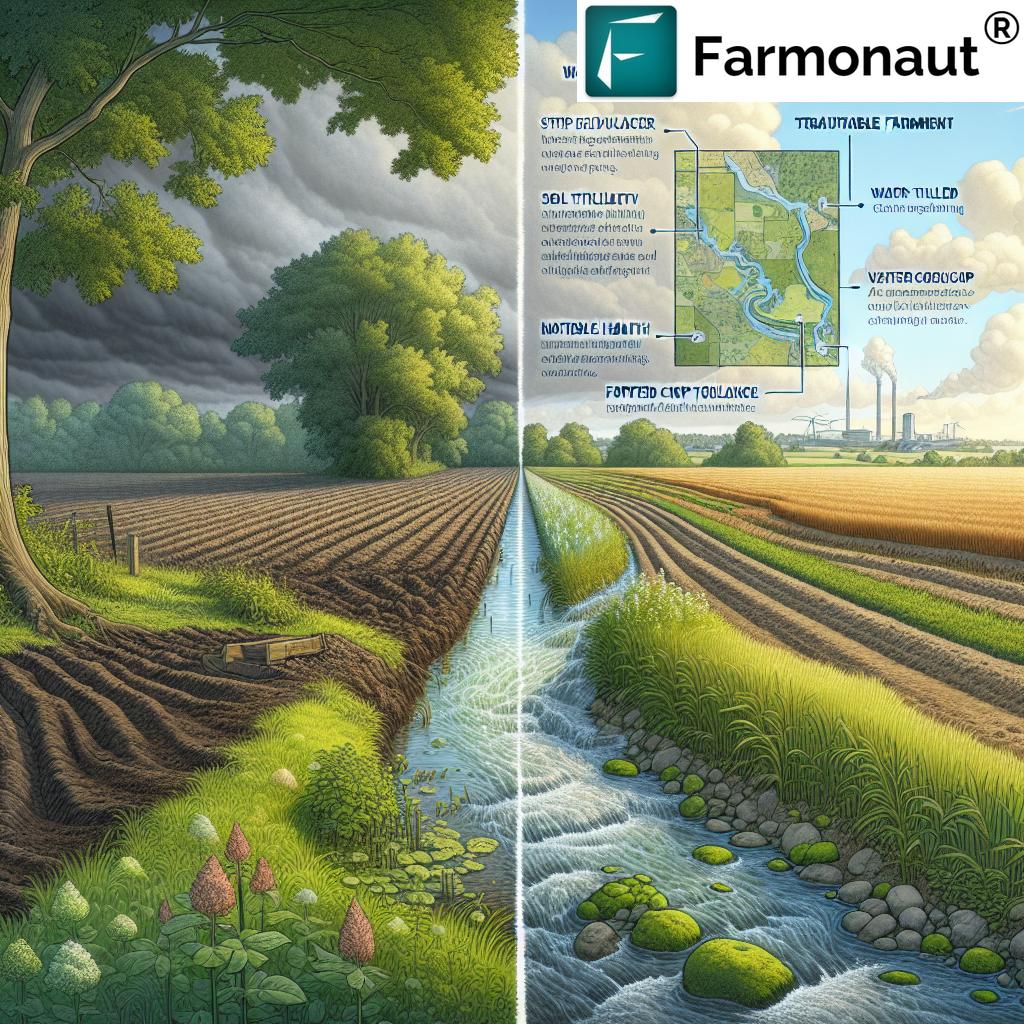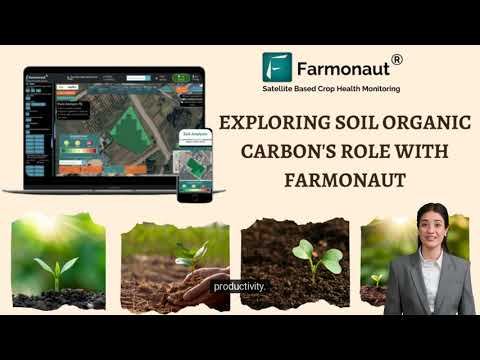Transforming Wisconsin’s Watersheds: Sustainable Farming Practices for Soil and Water Conservation in Brown County
“Brown County’s soil and water conservation roundtables bring together 3 key groups: farmers, agronomists, and watershed alliance members.”
In the heart of Wisconsin, a remarkable transformation is taking place. Brown County, known for its rich agricultural heritage, is at the forefront of a movement that’s reshaping the future of farming and environmental protection. We’re witnessing a convergence of innovative minds and sustainable practices that promise to revitalize our watersheds and secure a healthier future for generations to come.
As we delve into this exciting journey of agricultural evolution, let’s explore how soil and water conservation roundtables are bringing together farmers, agronomists, and watershed alliance members to promote sustainable farming practices and improve water quality in Brown County and beyond.
The Urgency of Watershed Conservation in Brown County
Brown County’s landscape is dotted with fertile fields and crisscrossed by vital waterways. From the majestic Fox River to the shores of Green Bay, our water resources are not just scenic beauties but the lifeblood of our communities. However, conventional farming practices have, over time, contributed to challenges that we can no longer ignore.
- Soil erosion threatening long-term agricultural productivity
- Nutrient runoff impacting water quality in rivers and lakes
- Declining soil health affecting crop resilience and yields
These issues have spurred a collective realization: we must act now to preserve our natural resources while maintaining a thriving agricultural sector. This is where the concept of watershed management comes into play, emphasizing the interconnectedness of our land and water systems.

The Power of Conservation Roundtables
At the heart of this transformation are the soil and water conservation roundtables. These gatherings are more than just meetings; they’re incubators for change, where ideas flow as freely as the waters we aim to protect. Here’s what makes these roundtables so impactful:
- Diverse Participation: Farmers, agronomists, and watershed alliance members come together, each bringing unique perspectives and expertise.
- Knowledge Sharing: Participants discuss innovative agricultural conservation techniques, from no-till farming methods to the benefits of cover crops.
- Collaborative Problem-Solving: By addressing challenges collectively, we’re finding solutions that work for both agriculture and the environment.
- Long-Term Vision: The focus is on creating sustainable systems that will benefit our community for years to come.
These roundtables are not just talk—they’re catalysts for action. As Katie Woodrow, Fox-Wolf Watershed Alliance Lower Fox Watershed Director, aptly puts it, “Water is important to all of us. So it’s not just for drinking, it’s for good quality of life. They want beautiful places to recreate, and to walk on paths near. All those things are tied together, and we want to make sure that we’re conserving those resources for future generations.”
Innovative Agricultural Conservation Techniques
“No-till farming and cover crops are 2 primary conservation techniques discussed to prevent nutrient runoff and enhance soil health.”
At the heart of these conservation efforts are innovative farming practices that are revolutionizing how we approach agriculture in Brown County. Let’s explore some of the key techniques being implemented and discussed:
1. No-Till Farming: Preserving Soil Structure
No-till farming is a practice that’s gaining significant traction among Brown County farmers. This method involves planting crops without disturbing the soil through tillage. The benefits are numerous:
- Reduced soil erosion by up to 90%
- Improved soil structure and water retention
- Increased organic matter in the soil
- Lower fuel and labor costs for farmers
By minimizing soil disturbance, no-till farming helps keep valuable topsoil in place, preventing it from being washed away into our waterways. This not only preserves the health of our fields but also significantly reduces sediment pollution in our rivers and lakes.
2. Cover Crops: Nature’s Soil Guardians
Cover crops are plants grown to cover the soil rather than for harvest. They play a crucial role in sustainable farming practices:
- Protect soil from erosion during off-seasons
- Suppress weed growth naturally
- Enhance soil fertility by fixing nitrogen
- Improve soil structure and water infiltration
As Barry Fisher, a soil health agronomist and consultant, explains, “We’ve got a situation where some of our nutrients are getting away from us, in our conventional systems. Some of our soil is getting away from us, and it’s finding its way to our water.” Cover crops act as a natural barrier, keeping soil and nutrients where they belong—in the fields.

3. Precision Nutrient Management
Efficient nutrient management is crucial for both crop productivity and environmental protection. Modern technologies are helping farmers apply the right amount of nutrients at the right time and place:
- Soil testing to determine precise nutrient needs
- Variable-rate application technology
- Use of slow-release fertilizers
- Timing fertilizer application to match crop uptake
These practices not only optimize crop yields but also significantly reduce the risk of nutrient runoff into our watersheds. It’s a win-win for farmers and the environment.
The Role of Technology in Sustainable Farming
As we embrace these sustainable farming practices, technology plays a crucial role in making them more effective and accessible. One such technological advancement comes from Farmonaut, a pioneering agricultural technology company that offers advanced, satellite-based farm management solutions.
Farmonaut’s platform provides valuable services such as:
- Real-time crop health monitoring
- AI-based advisory systems
- Blockchain-based traceability
- Resource management tools
These technologies enable farmers to make data-driven decisions, optimizing their use of resources while minimizing environmental impact. For instance, satellite-based crop health monitoring can help farmers identify areas that need attention, reducing the need for blanket applications of fertilizers or pesticides.
For those interested in integrating these advanced technologies into their own systems, Farmonaut offers an API with comprehensive developer documentation.
The Impact of Sustainable Farming on Water Quality
The adoption of sustainable farming practices in Brown County is having a profound impact on water quality. By reducing soil erosion and nutrient runoff, we’re seeing improvements in our local waterways:
- Decreased sedimentation in rivers and lakes
- Reduced algal blooms in Green Bay
- Improved habitat for aquatic life
- Enhanced recreational opportunities for residents and tourists
While the full effects of these conservation efforts may take years to fully manifest, early indicators are promising. As Katie Woodrow notes, “Everyone has a little piece that they can do. It’s not just residents. It’s not just farmers. It’s not just the cities. It’s everybody together that makes a collective difference.”
Sustainable Farming Practices: Impact on Soil and Water Conservation in Brown County
| Farming Practice | Soil Health Benefits | Water Quality Improvements |
|---|---|---|
| No-Till Farming | Reduces erosion by up to 90% | Decreases sediment in waterways by 70% |
| Cover Crops | Increases organic matter by 1-2% annually | Reduces nutrient runoff by approximately 30% |
| Nutrient Management | Optimizes soil fertility | Decreases phosphorus runoff by up to 45% |
| Buffer Strips | Prevents soil loss at field edges | Filters out up to 50% of nutrients and pesticides |
The Economic Benefits of Sustainable Farming
While the environmental benefits of sustainable farming practices are clear, it’s equally important to recognize the economic advantages for farmers and the broader community:
- Reduced Input Costs: No-till farming and precision nutrient management can significantly lower expenses for fuel, fertilizers, and pesticides.
- Improved Soil Productivity: Healthier soils lead to better crop yields over time, increasing farm profitability.
- Resilience to Climate Variability: Sustainable practices help farms better withstand drought and extreme weather events.
- New Market Opportunities: Growing consumer demand for sustainably produced foods can open up premium markets for farmers.
Barry Fisher emphasizes this point: “It’s a path worth attempting. It’s the farmers are finding that those who have been successful in this transition, are having a more resilient cropping system, and they’re also going to have a more marketable product. So I think it’s going to be a way of the future.”
Challenges and Solutions in Transitioning to Sustainable Practices
While the benefits of sustainable farming are clear, the transition can present challenges for farmers. Some common obstacles include:
- Initial investment in new equipment or technologies
- Learning curve associated with new farming methods
- Short-term yield reductions during the transition period
- Resistance to change from traditional farming mindsets
To address these challenges, the conservation roundtables and local organizations are providing support through:
- Education and Training: Workshops and field days to demonstrate new techniques
- Financial Incentives: Grants and cost-sharing programs to help offset transition costs
- Peer-to-Peer Networks: Connecting farmers to share experiences and best practices
- Technical Assistance: On-farm consultations with agronomists and soil health experts
By providing these resources, we’re helping farmers overcome barriers and embrace sustainable practices that benefit both their operations and the environment.
The Future of Farming in Brown County
As we look to the future, the path forward for agriculture in Brown County is clear. Sustainable farming practices are not just a trend but a necessity for long-term agricultural viability and environmental health. Here’s what we envision for the coming years:
- Widespread Adoption: More farmers transitioning to conservation practices
- Continued Innovation: Development of new technologies and techniques to enhance sustainability
- Improved Water Quality: Significant reductions in nutrient runoff and sediment pollution
- Enhanced Biodiversity: Healthier ecosystems supporting a variety of plant and animal species
- Stronger Rural Communities: More resilient and profitable farms supporting local economies
The journey towards this future is already underway, driven by the collaborative efforts of farmers, researchers, and community organizations. As Katie Woodrow notes, it may take 20 years to see significant improvement, but every step we take brings us closer to our goal.
The Role of Community in Watershed Conservation
While farmers are at the forefront of this agricultural revolution, the entire community plays a crucial role in supporting and amplifying these conservation efforts:
- Consumers: By choosing locally grown, sustainably produced foods, consumers can support farmers who adopt conservation practices.
- Residents: Implementing water-saving measures and reducing chemical use in home gardens contributes to overall watershed health.
- Schools: Educational programs can teach the next generation about the importance of soil and water conservation.
- Local Businesses: Partnering with farms for sustainability initiatives can create a stronger, more resilient local economy.
As we’ve learned from the conservation roundtables, every individual has a role to play in protecting our watersheds and ensuring a sustainable future for Brown County.
Leveraging Technology for Sustainable Agriculture
In our journey towards sustainable farming, technology serves as a powerful ally. Innovative solutions, like those offered by Farmonaut, are making precision agriculture more accessible and affordable for farmers of all scales. Here’s how technology is transforming sustainable farming practices:
- Satellite-Based Crop Monitoring: Real-time data on crop health allows for targeted interventions, reducing the need for blanket applications of fertilizers or pesticides.
- AI-Driven Advisory Systems: Personalized recommendations help farmers make informed decisions about planting, irrigation, and harvesting.
- Blockchain for Traceability: Ensuring transparency in the food supply chain, from farm to consumer.
- Resource Management Tools: Optimize the use of water, fertilizers, and other inputs, reducing waste and environmental impact.
These technological advancements not only improve farm efficiency but also contribute significantly to our soil and water conservation goals.
Earn With Farmonaut: Earn 20% recurring commission with Farmonaut’s affiliate program by sharing your promo code and helping farmers save 10%. Onboard 10 Elite farmers monthly to earn a minimum of $148,000 annually—start now and grow your income!
Measuring Progress: Key Indicators of Success
As we implement these sustainable farming practices across Brown County, it’s crucial to track our progress. Here are some key indicators we’re monitoring:
- Water Quality Metrics: Regular testing of rivers, lakes, and groundwater for nutrients, sediments, and contaminants.
- Soil Health Assessments: Measuring organic matter content, soil structure, and biological activity in agricultural lands.
- Biodiversity Indicators: Tracking populations of key species that reflect ecosystem health.
- Farm Productivity Data: Monitoring crop yields and farm profitability to ensure economic sustainability.
- Adoption Rates: Tracking the number of farms implementing conservation practices.
By closely monitoring these indicators, we can adjust our strategies and ensure we’re making meaningful progress towards our conservation goals.
Conclusion: A Collective Vision for Brown County’s Future
As we conclude our exploration of sustainable farming practices in Brown County, it’s clear that we’re at the cusp of a transformative era in agriculture. The conservation roundtables have ignited a powerful movement, bringing together farmers, agronomists, and watershed alliance members in a collective effort to protect our soil, water, and future.
From no-till farming and cover crops to precision nutrient management and advanced technologies, we’re embracing practices that not only conserve our natural resources but also ensure the long-term viability of our agricultural sector. These efforts extend far beyond the farm, impacting the quality of our drinking water, the beauty of our recreational areas, and the overall health of our ecosystems.
As Katie Woodrow wisely noted, it may take time to see the full impact of our efforts, but every step we take brings us closer to our goal of a sustainable, thriving Brown County. By working together—farmers, residents, businesses, and local organizations—we’re creating a future where agriculture and environmental stewardship go hand in hand.
The transformation of Wisconsin’s watersheds is not just a dream; it’s a reality we’re building today, one sustainable practice at a time. As we look to the future, we can be proud of the legacy we’re creating—a legacy of healthy soils, clean waters, and resilient communities that will benefit generations to come.
FAQs
- What are the main benefits of no-till farming?
No-till farming reduces soil erosion, improves soil structure, increases water retention, and lowers fuel and labor costs for farmers. - How do cover crops contribute to soil and water conservation?
Cover crops protect soil from erosion, suppress weeds, enhance soil fertility, and improve water infiltration, reducing runoff and nutrient loss. - What role does technology play in sustainable farming?
Technology like satellite-based crop monitoring, AI advisory systems, and precision agriculture tools help farmers optimize resource use and reduce environmental impact. - How long does it take to see improvements in water quality from sustainable farming practices?
While some benefits can be seen quickly, significant improvements in water quality may take up to 20 years, according to experts. - How can consumers support sustainable farming in Brown County?
Consumers can support sustainable farming by choosing locally grown, sustainably produced foods and engaging in community conservation efforts.






